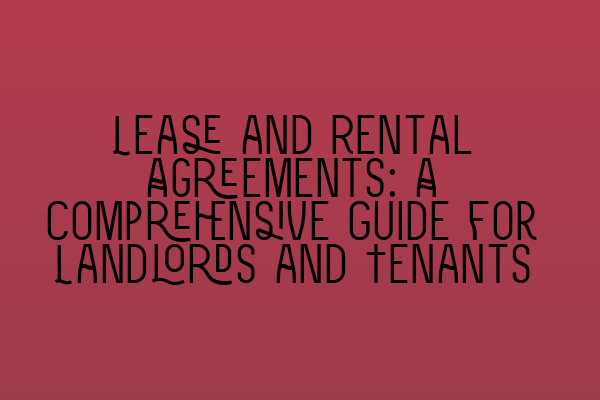Lease and Rental Agreements: A Comprehensive Guide for Landlords and Tenants
Introduction
Lease and rental agreements are crucial legal documents that govern the relationship between landlords and tenants. Whether you are a landlord looking to lease out your property or a tenant searching for a rental home, understanding the intricacies of these agreements is essential. In this comprehensive guide, we will delve into the various aspects of lease and rental agreements and provide valuable insights for both landlords and tenants.
1. Understanding Lease and Rental Agreements
A lease agreement is a binding legal contract between a landlord and a tenant that outlines the terms and conditions of renting a property for a fixed period. On the other hand, a rental agreement is a more flexible arrangement that typically runs on a month-to-month basis. Both agreements define the rights and responsibilities of both parties involved, ensuring a harmonious tenancy.
2. Key Elements of Lease and Rental Agreements
a) Names and Contact Information: The lease or rental agreement must clearly state the names and contact information of both the landlord and tenant, making it easy to communicate and resolve any issues.
b) Property Description: It is essential to include a detailed description of the rental property, including its address, size, and any specific features or restrictions. This helps avoid any confusion or misunderstandings.
c) Rent and Payment Terms: Clearly state the agreed-upon rent amount, payment due dates, accepted payment methods, and any penalties for late payments. This ensures both parties are on the same page regarding financial obligations.
d) Lease Duration: If it is a lease agreement, specify the lease duration, whether it is for a fixed term (e.g., 6 months, 1 year) or periodic term (e.g., month-to-month). Rental agreements typically have shorter durations or operate on a rolling basis.
e) Security Deposit: Discuss the amount of the security deposit required, its purpose, and the conditions for its return at the end of the tenancy. This safeguards the landlord against potential damages and provides a sense of security for tenants.
f) Maintenance and Repairs: Clearly define the responsibilities of both parties regarding property maintenance and repairs. This aspect should cover small repairs, major maintenance, and potential penalties for negligence.
g) Termination and Renewal: Outline the conditions for terminating the agreement by both the landlord and tenant, as well as any provisions for renewal or extension of the lease. This ensures a smooth transition when the tenancy concludes.
3. Landlord’s Responsibilities
As a landlord, it is vital to understand your responsibilities to maintain a functional and safe rental property. Here are some crucial aspects to consider:
a) Property Maintenance: Landlords must ensure that the property meets all safety and health standards, including regular maintenance of plumbing, electrical systems, and structural integrity.
b) Safety Regulations: Compliance with local safety regulations, such as smoke detectors, fire extinguishers, and carbon monoxide detectors, is mandatory to protect tenants.
c) Prompt Repairs: Responding to repair requests in a timely manner is crucial to maintain a good landlord-tenant relationship and ensure tenant satisfaction.
d) Privacy Rights: Respecting the tenant’s privacy and providing proper notice before entry is essential. Check local laws regarding notice periods for entry.
4. Tenant’s Responsibilities
Tenants also have certain responsibilities that contribute to a smooth tenancy:
a) Rent Payment: Paying rent on time and in the agreed-upon manner is crucial to maintain a good relationship with the landlord and avoid any conflicts.
b) Property Care: Tenants are expected to keep the rental property clean and tidy, avoiding any intentional damages or neglect that may result in additional charges.
c) Reporting Maintenance Issues: Alerting the landlord promptly about any maintenance or repair issues prevents further damages and facilitates prompt resolution.
d) Compliance with Terms: Tenants must adhere to the terms and conditions of the agreement, including noise restrictions, pet policies, and any other rules set forth by the landlord.
5. Seeking Legal Assistance
Given the legal implications and complexities associated with lease and rental agreements, it is advisable for both landlords and tenants to seek professional legal assistance. A solicitor experienced in contract law can review the agreement, offer expert advice, and ensure compliance with relevant regulations.
Conclusion
Lease and rental agreements play a crucial role in establishing a fair and mutually beneficial relationship between landlords and tenants. Understanding the key components and responsibilities within these agreements is essential for a successful tenancy. By following the guidelines outlined in this comprehensive guide, both landlords and tenants can navigate the rental landscape with confidence.
Related Articles:
– SQE 1 Practice Exam Questions
– SQE 1 Practice Mocks FLK1 FLK2
– SQE 2 Preparation Courses
– SQE 1 Preparation Courses
– SRA SQE Exam Dates
